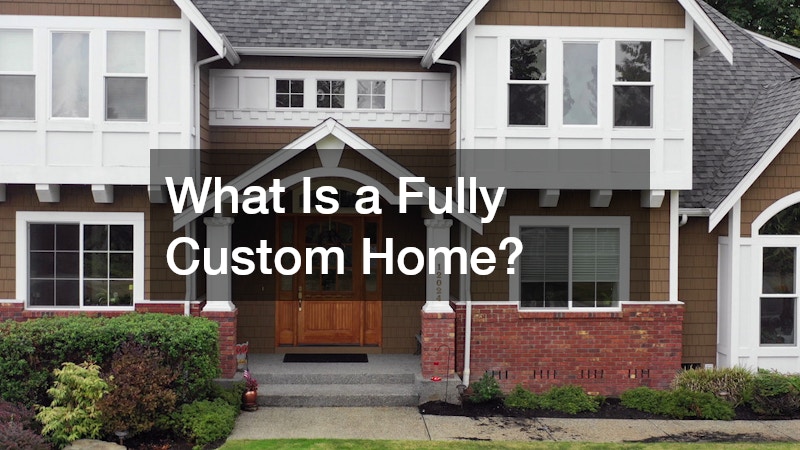- Semi-custom homes offer faster build times and lower costs while still allowing some personalization.
- Fully custom homes provide complete design freedom but come with higher costs, longer timelines, and more decisions.
- Well-reviewed home builders that offer custom services can deliver excellent results in both semi and full custom scenarios—choosing the right builder is critical.
- Budget planning is essential for both options, with fully custom homes requiring a larger contingency reserve for design changes.
- Lifestyle factors—such as family size, aging-in-place needs, or desire for smart-home features—should guide your decision.
- Myths like “fully custom is always better” or “semi-custom means poor quality” are often false and depend on the builder’s reputation and transparency.
- Choosing between semi-custom and fully custom should balance personalization needs, time constraints, and long-term goals.
When shopping for well‑reviewed home builders that offer custom services, one of the very first choices homeowners face is deciding between semi‑custom and fully custom new homes. As of mid‑2025, custom home building remains a resilient segment—even while broader housing starts have flattened year over year, custom starts account for approximately 18% of single‑family production and have grown ~2% over the past four quarters . In a U.S. home building industry valued at roughly $430 billion, with average single‑family costs near $297 000 and typical completion times of about seven months , choosing the right custom path matters more than ever.
This guide explores the defining traits of semi‑custom versus fully custom homes, how well‑reviewed home builders that offer custom services support each route, and critical considerations around cost, timeline, lifestyle fit, and design flexibility.
I. Introduction
Homeowners increasingly seek personalization in new home construction. Demand for well‑reviewed home builders that offer custom services continues because clients value uniqueness, sustainability, and smart‑home integration. In 2025, nearly 44% of new homes include energy‑efficient or green features, and smart home tech adoption surged 44% from 2018 to 2022.
Yet while construction technology evolves—BIM, prefab panels, modular builds that reduce costs and speed up delivery by up to 50%—economic headwinds persist. Tariffs, higher material costs, and mortgage rates hovering around mid‑6% continue to drive builder caution in pricing and incentives . Against this backdrop, selecting between a semi‑custom versus fully custom home with a reputable builder becomes a strategic decision, balancing personalization with budget, timeline, and risk.
II. What Is a Semi‑Custom Home?
Semi‑custom homes use pre‑designed floor plans provided by well‑reviewed home builders that offer custom services. Buyers may tweak layout options, choose fixtures, finishes, and sometimes adjust square footage—but core architectural design remains firm.
Typical Process
- Select a base plan from the builder’s portfolio
- Adjust limited elements: garage placement, room additions, material upgrades
- Choose finishes: flooring, cabinetry, countertops, lighting packages
- Finalize selections, then construction begins—typically faster than full custom
Advantages
- Shorter timeline: often around 6–8 months from start to finish
- Lower cost: per‑square‑foot rates typically 10–20 % below full custom
- Streamlined choices: limited but focused decision points reduce overwhelm
- Many well‑reviewed builders offer transparent packages and incentives for semi‑custom options
Drawbacks
- Less design freedom—structural layout generally fixed
- Homes may look similar across neighborhoods (cookie‑cutter feel)
- Limited ability to tailor the build to specific land constraints or unique lifestyle needs
III. What Is a Fully Custom Home?

A fully custom home is designed and built from the ground up to meet a homeowner’s individual vision. Every detail—from footprint to ceiling height, custom millwork to integrated tech—is created uniquely, usually in collaboration with architects, designers, and custom home builders.
Typical Process
- Purchase or contract land
- Hire architect/designer to create plans
- Work with well‑reviewed home builders that offer custom services to cost out and execute the design
- Review and select structural, mechanical, aesthetic, and landscape components in full detail
- Construction typically takes 9–12+ months depending on complexity and scale
Upsides
- Total design freedom—ideal for distinctive lots, site‑specific features, or individualized floor plans
- High resale value when crafted well, thanks to uniqueness, quality, and craftsmanship
- Strong builder collaboration can incorporate latest trends: smart home systems, sustainable materials, wellness‑design
Cons
- Longer timelines: project durations often reach 12–15 months from planning to completion
- Higher cost: often 20% or more above semi‑custom, with unexpected budget creep common (average overrun ~12%)
- Decision fatigue: design process involves dozens of choices; must be comfortable with involvement
IV. Key Differences Between Semi‑Custom and Fully Custom
| Feature | Semi‑Custom Homes | Fully Custom Homes |
| Design Flexibility | Moderate—template‑based with limited tweaks | Complete—plans built from your vision |
| Cost per Square Foot | Generally lower (10–20% savings over full custom) | Higher—reflects design originality and bespoke details |
| Typical Timeline | 6–8 months | 9–15 months depending on complexity |
| Owner Involvement | Moderate—focus on finishes and modest alterations | High—strategic decisions on every aspect |
| Builder Role | Uses builder’s existing model library | Builds from architectural plans you commission |
| Land Requirements | Builder often provides lots or community | You must select and secure your own land |
| Custom Design Professionals | Optional architect or designer support | Architect and interior designer typically essential |
V. Budget Considerations: What Can You Afford?
Typical Budgets & Benchmarks
- Semi‑custom: average U.S. build ~ $297 000, roughly $150–$200 per ft² depending on location and finishes
- Fully custom: $200–$400+ per ft², depending on land, finishes, scale, and design complexity
Hidden and Variable Costs
- Permits, site grading, utility hookups, lot purchase
- Custom upgrades: high‑end appliances, unique cabinetry, specialty lighting
- Design fees: architects, structural engineers, interior designers
- Contingency reserve: 10–15% buffer for unanticipated changes
Financing Pathways
- Construction loans converted to mortgages
- Home equity financing for renovations or custom upgrades
- Some custom builders offer rate buy‑down financing or price guarantees
Cost Control Tips
- Choose trusted, well‑reviewed home builders that offer custom services with software tools for cost tracking
- Fix boundaries early: define square footage, finishes, structural changes clearly
- Use value-engineering collaboratively to stay within budget without compromising quality
- Monitor allowances and selection deadlines—late changes mean cost creep
VI. Lifestyle Considerations: Which Fits Your Needs?
Ask yourself:
- Do you require flexible or multi‑use spaces, such as home offices that convert to guest rooms?
- Are you detail-oriented and eager to choose every finish?
- Do you prefer move-in ready structure or a step-by-step interactive design process?
- Is your lot uniquely shaped, sloped, or with particular site characteristics?
Match to Life Stages
- Young families often lean toward semi‑custom for fast move‑in and lower cost, upgrading key areas like kitchen or bath
- Empty‑nesters or long‑term homeowners often choose fully custom to create aging‑in‑place design, wellness features, or accessory dwelling units
Trend Alignment (2025 Focus)
- Flex spaces and adaptable zones increasingly in demand, especially given remote work becoming normalized truehomes.com
- Wellness‑driven design: green materials, air quality, natural lighting—often easier to integrate in fully custom builds
- Smart home and sustainability features—both approaches can adopt, but advanced integration more accessible via full custom Graphic junkies
VII. Common Myths About Custom Homes
- “A fully custom home is automatically better.”
- Quality matters more than ‘custom’ label. Some well‑reviewed semi‑custom builders deliver high-end finishes and solid craftsmanship.
- “Semi‑custom homes are cheap quality.”
- Not so: trusted custom builders often use the same trades, certifications (LEED, ENERGY STAR), and smart‑home packages in semi‑custom options en.wikipedia.org.
- “Custom homes always blow the budget.”
- Budget overruns average ~12%, but disciplined planning, clear allowances, and solid builder relationships help limit surprises worldmetrics.org.
- “Only affluent homeowners can afford fully custom.”
- While costs are higher, creative financing and phased custom approaches (e.g. starting with semi‑custom base, later custom upgrades) make full personalization achievable.
VIII. Builder Selection: Choosing the Right Partner

Finding Well‑Reviewed Gentle Experts
- Search platforms like Houzz, BBB, Google, and specialized awards (e.g. Parade of Homes)
- Look for builders that consistently receive high ratings and showcase transparent processes
Verification Checklist
- Licensing and insurance
- Portfolio and model homes you can tour in person or virtually
- References and past client testimonials
- Warranties and post‑build support (e.g. 10‑year structural, 1‑year workmanship)
Questions to Ask
- What’s your average timeline for semi‑custom vs fully custom homes?
- Do you offer transparent pricing software or allowances?
- How do you integrate smart home systems and green building?
- Who manages subcontractors? Do you use off‑site or panelized methods?
- What processes do you have to minimize budget overruns or delays?
Value of Early Involvement of Designers
- Engaging an architect or interior designer early can help you define scope, sight setbacks, and anticipatory cost planning
- Custom homes with integrated architecture and builder teams (design-build firms) often deliver more efficient results and stronger quality control
IX. Case Studies
Scenario 1: Young Family Chooses Semi‑Custom with Upgrades
- Family of four selects builder’s semi‑custom plan in a known subdivision
- They upgrade kitchen, add bay windows, and choose luxury finishes
- Finished in ~8 months, staying within 10% of budget
- Result: Personalized without stretching timeline or financing
Scenario 2: Retired Couple Builds Fully Custom Aging‑in‑Place Home
- Purchased a wooded lot on a lake
- Commissioned architect to design a single-story home with zero‑step entry, wide hallways, multi‑gen suite, and sunroom
- Integrated solar power, smart HVAC, and energy‑efficient envelope
- Took 14 months to complete, but delivered a long‑term home matched precisely to their lifestyle
X. Final Decision: Checklist to Choose What’s Right for You
Use this decision‑making checklist before committing:
- Do you need complete architectural customization or simply tailored finishes?
- Is your timeline flexible or fixed (e.g. needs to move in before school starts)?
- What is your true budget—including contingency?
- Will you remain actively involved in dozens of design decisions?
- Does your lot require site-specific solutions or unique layout considerations?
- Do you prioritize sustainability, wellness‑design, or tech integration at a deeper level?
XI. Conclusion :Making the Right Choice for Your Future Home
Choosing between a semi-custom and a fully custom home isn’t just about budget or timeline—it’s about lifestyle, long-term goals, and your comfort in the decision-making process. If you value full control and unique design features, a fully custom home might be ideal. But if you want a more streamlined process with some personalization, a semi-custom home could be the perfect balance.
Before you start planning, it’s wise to evaluate your lifestyle needs, available time, and decision-making bandwidth. Working with well-reviewed home builders that offer custom services ensures you’re not sacrificing quality, regardless of which path you take.
For more insights on building the perfect home from the ground up, check out this guide on choosing the right gear and safety equipment for home construction projects at Ace Work Gear — perfect for homeowners planning to be hands-on or managing site visits during construction.
Recommended Resources & Guides
-
National Association of Home Builders (NAHB) – Custom vs. Production Homes
(An official comparison from a trusted industry source.) -
Architectural Digest – What to Know Before Building a Custom Home
(Great insights on expectations, timeline, and planning.) -
U.S. News Real Estate – The Pros and Cons of Building a Custom Home
(Helps balance personalization with cost, effort, and time.) -
Houzz – Designing Your Dream Home: Custom vs. Semi-Custom
(A user-friendly, visual approach to understanding both paths.)
